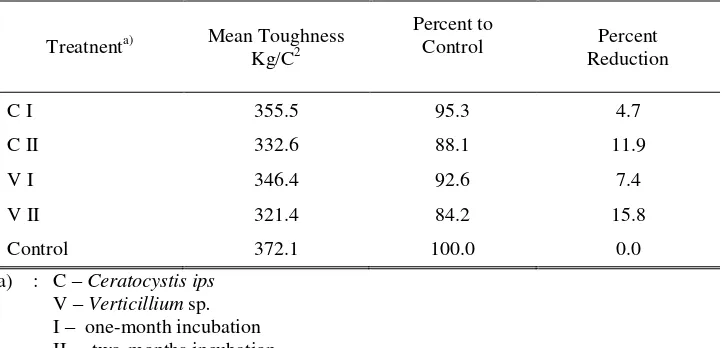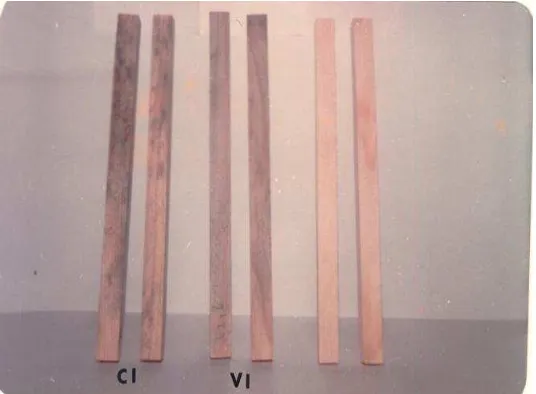Trop. For. Manage. J. X (1) : 61-66 (2004)
EFFECT OF BLUE STAIN ON THE TOUGHNESS OF BENGUET
PINE (
Pinus kesiya
Royle ex. Gordon) WOOD
Pengaruh Blue Stain Terhadap “Daya Tahan Beban Tiba
-
Tiba “ Kayu
Pinus Benguet (Pinus kesiya
Royle ex. Gordon
)
I G. K. TAPA DARMA1)
ABSTRAK
Kualitas kayu pinus Beunguet dipengaruhi oleh banyak faktor, diantaranya serangan blue stain sangat mempengaruhi sifat-sifat kayu seperti keindahan dan ”daya tahan beban tiba-tiba” (toughness) kayu serta mengurangi nilai jual dan pemasaran kayu. Tujuan dari penelitian ini adalah untuk mengetahui pengaruh serangan blue stain terhadap daya tahan beban tiba-tiba dari kayu pinus Benguet (Pinus kesiya Royle ex. Gordon) pada berbagai periode inkubasi.
Ternyata hasil penelitian ini menunjukkan daya tahan beban tiba-tiba kayu pinus Benguet yang diserang blue stain baik yang diinkubasi selama satu bulan maupun dua bulan atau kontrol tidak menunjukkan perbedaan yang nyata. Meskipun demikian, ada indikasi yang ditunjukkan oleh waktu inkubasi, semakin lama kayu diinkubasikan maka semakin berkurang daya tahan beban tiba-tiba dari kayu.
Keywords: Pinus kesiya Royle ex. Gordon, blue stain, toughness
INTRODUCTION
Benguet pine (Pinus kesiya Royle ex. Gordon) is widely planted in Asia, Africa, South and Central America and the Pacific Region as industrial plantation or timber production species. As the demand for wood from year to year increases, Benguet pine has a good prospect as a substitute raw material for current species being used in many wood industries.
The quality of the wood produced by Banguet pine is affected by many factors. One of the most important factors is the blue stain. It affects the important properties such as the aesthetic quality and toughness of the wood, reducing grade value and marketability (Boyce, 1961; Hunt and Garratt, 1953; Eusebio, 1968).
Scheffer (1973) stated that blue stain ordinarily is accompanied by very little reduction of wood strength except for toughness or shock resistance. Chapman and Scheffer (1960) concluded that in intensely stained pine sapwood, there might commonly be reductions of 1-2 percent in specific gravity and 15 – 0 percent in toughness. Cartwright and Findlay (1958) reported that there is a 20 percent reduction in bending
1)
strength and 43 percent reduction in toughness of stained tropical hardwoods. Also, Eusebio (1968) reported that reduction in toughness of sapwood of eastern white pine varies from 0.46 to 42.9 percent depending on the mode of penetration and the fungi themselves.
Discoloration makes wood more vulnerable to decay by increasing its permeability and resulting susceptibility to serious rain wetting and consequently readily attacked by decay fungi (Sceffer, 1973). Considering the information above, it is important to study the blue stain of Banguet pine. The objective of this study therefore is to determine the effect of blue stain on the toughness of the wood.
MATERIALS AND METHODS
Test Fungi
Test fungi used in this experiment were Ceratocystis ips Rumbs, and Verticillium sp. originated from laboratory stock-cultures.
Preparation of test specimens
Thirty test specimens, each measuring 2.0 cm x 2.0 cm x 27.94 cm were sawn as quarter sawn stick from stain-free sapwood of Benguet pine. Twenty four test specimens were inoculated with test fungus under one-or two-month incubation period respectively, and the others served as control. There were 6 test specimens for each fungus for every incubation period, three of which were used to determined toughness on the radial section while the other three were used for toughness test on the tangential section.
Preparation of stain chamber
One thousand milliliters Witeg and Superior graduated cylinders were used as stain chambers. Galvanized wire support platform were placed at the bottom of the cylinder and the mouth was plugged with cotton. The chambers were sterilized in a hot oven at 160°C for 2 hours. After sterilization, 50 ml of sterile distilled water was added into each chamber to provide adequate moisture during the incubation period.
Sterilization, inoculation and incubation of test specimens
Toughness testing
At the end of the incubation period, the test specimens were tested for their tough-ness. The control specimens were tested at the beginning of the experiment, just after they were surface sterilized in boiling distilled water for one minute. All specimens were tested in their green condition by using toughness test machine (ASTM 1972).
Experimenta1 design and statistical analysis
To analyse the effects of incubation period of the stain fungi on the toughness of wood, a completely randomized design was used.
RESULTS AND DISCUSSIONS
The percent reduction of toughness of Benguet pine sapwood after one-month and two-month incubation with C. ips and Verticillium sp. is presented in Tab1e 1. Toughness was reduced as the incubation period for both of the test fungi increased. Statistically, there was no difference between the treatments. Both fungi, C. ips and Verticillium sp. either under one or two-months incubation period or as control have the same effect on toughness of wood.
Table 1. Percent reduction in toughness of Benguet pine sapwood after one-month and two-month inoculated by C. ips and Verticillium sp.
Treatnenta) Mean Toughness
Kg/C2
Percent to
Control Percent
Reduction
C I 355.5 95.3 4.7
C II 332.6 88.1 11.9
V I 346.4 92.6 7.4
V II 321.4 84.2 15.8
Control 372.1 100.0 0.0
a) : C – Ceratocystis ips V – Verticillium sp. I – one-month incubation
II – two-months incubation
Figure 1. Test specimens attacked by C. ips (CI) showing bluish dark color and Verticillium sp. (VI) showing grayish dark color, after one-month incubation period at 28°C. The two others showing free stain, yellow to reddish color are untreated specimens.
After 2-months incubation, reduction in toughness was higher than after 1-month incubation. It might be that 1-month incubation did not give enough time for the stain fungi to develop and degrade various cell contents. After 2-months incubation, the fungi developed and degraded the wood more severely. Chapman and Scheffer (1960) stated that duration of favorable conditions for staining is an important factor in determining the extent of weakening. Campbell (1959) reported that reduction in toughness of Liquidambar styraciflua L. sapwood attacked by C. pluriannulata Hedge., was statistically significant after 17 weeks incubation. The toughness of pinus sylvestris L. sapwood inoculated with Ceratostomella coerulea (Fries) C. Morean, after 26 weeks incubation was reduced seriously. Within 3 weeks the reduction was increased to 40 percent (Findlay and Pettifor, 1937).
Chapman and Scheffer (1960) found that C. pilifera (Fr.) Wint., C. ips, C.pini Munch, and Graphium rigidum (Pers.) Sacc. had different effects to the same species of wood as well as different species one. A very good example is Botryodiplodia theobromae Pat. which caused reduction in toughness of Obeche (Triplochiton scleroxylon K. Sehun) to 43 percent in 3 months (Findlay and Pettifor, 1939). This fungus also caused reduction in toughness of Pouteria duclita (Blanco) Baehni to as much as 38.6 percent after one-month and 73.8 percent after three-one-month exposure (Arenas et al., 1968). The differences in reduction in of toughness were assumed to be due to the response of the fungus to the different wood species as substrate.
No significant effect of blue stain fungi, Diplodia pinea (Desm.) Kickx. on the reduction of toughness of Pinus radiata D. Don. sapwood was obtained whether tested green or air-dry (Da Costa, 1955 as cited by Campbell, 1959).
Considering the information presented above, toughness of some wood may be affected to some extent by some different staining fungi. For the wood where toughness is considered important in service, it is not advisable to use blue stained wood. Woods that are intensely stained look dirty and are not in demand by users where original mosaic pattern of wood is considered more exciting.
In this study, reduction in toughness was not significant. This means that both blue stained and sound wood of Benguet pine have similar strength properties, therefore both can be used for the same purposes where toughness is needed. However, if the wood is allowed to be colonized by stain fungi at a longer time, reduction in toughness is likely to
be more significant. That’s why, it is important that a further study be conducted to
determine the effect of longer incubation period on toughness of wood. Although the effects of blue stain on the other strength properties such as compression strength and bending strength are not significant (Campbell, 1959; Boyce, 1961), test must be done for the safety of users. Stained wood may contain incipient decay with important strength losses (Zabel, 1953). In favorable conditions, stain fungi will be followed by decay fungi attacking the wood. Eventually, stained wood in exposed conditions decays more rapidly than unstained one (Verral, 1951). Once decay is associated with blue stained wood it would affect all mechanical and physical properties of the wood.
CONCLUSIONS AND RECOMENDATION
Effect off blue stain on the toughness of wood, either under one or two-months incubation periods or without (control) was not significantly different or both blue stained woods, either under one or two months incubation periods and sound wood of Benguet pine have almost similar toughness. However, there was an indication that toughness decreased as the time of incubation is extended, percent reduction in toughness after 2 month incubation was higher than 1-month incubation for the two fungi causing blue stain, C. ips and Verticillium sp.
toughness and other strength of the wood are needed, tests should be undertaken to ensure safety.
LITERATURES CITED
Arenas. C. V., E. M. Mendoza and C. C. Banatin. 1968. The effect of staining fungus Diplodia theobromae (Pat.) Nowell on the toughness and bending strength properties of Duclitan (Pouteria duclitan (Blanco) Baehni). In A compilation of articiles on forest products entomology and pathology. Wood Preservation Service, FORPRODECOM. College, Laguna. pp. 57 – 60.
Boyce, J. S. 1961. Forest Pathology. 3rd Ed. New York, Toronto, London : McGraw-Hill Book Company.
Campbell, R. N. 1959. Fungus sap stain on hardwoods. Southern Lumberman. 199 (2489) : 115 – 120.
Cartwright, K. St. G. and W. P. K. Findlay. 1958. Decay of Timber and Its Prevention. 2nded. London : Her Majesty’s Stationery Office, 332 p.
Chapman, A. D. and T. C. Scheffer. 1960. Effect of blue stain on specific gravity and strength of Southern Pine. J. Agric. Res. 61 : 125 – 134.
Eusebio, M. A. 1968. Growth of five staining fungi and stain development in pine sapwood. Bureau of Printing. Manila. 97 p.
Findlay, W. P K. and C. B. pettifor. 1937. The effect of sap stain on the properties of timber. I. Effect of sap stain on the strength of Scots pine sapwood. Forestry 11(1) : 40 – 52.
Findlay, W. P K. and C. B. Pettifor. 1939. Effect of blue stain on the strength of Obeche (Triplochyton scleroxylon). Empire For. J. 18 : 259 – 267.
Hunt, G. M. and G. A. Garratt. 1953. Wood Preservation. 2nd ed. New York, Toronto, London : McGraw Hill Book Company, Inc. 417 p.
Scheffer, T. C. 1973. Microbiological degradation and the causal organisms. In D. D. Nicholas (eds.). Wood deterioration and its prevention by preservative treatments. Vol. 1. Degradation and Protection of wood. Syracuse Univ. Press. pp. 31 – 106.
Verrall, A. T. 1951. Permanence for wood aiding. U.S. Dept. Agric. Forest Pathology, Special Release. No. 36.

